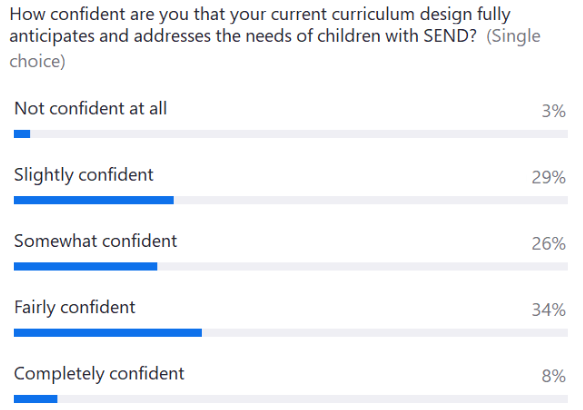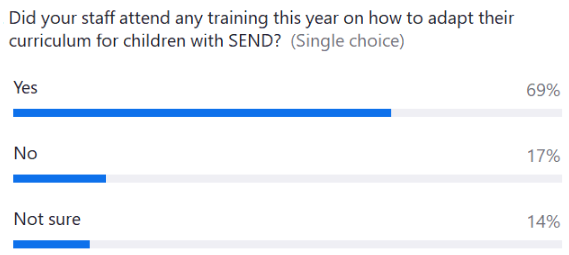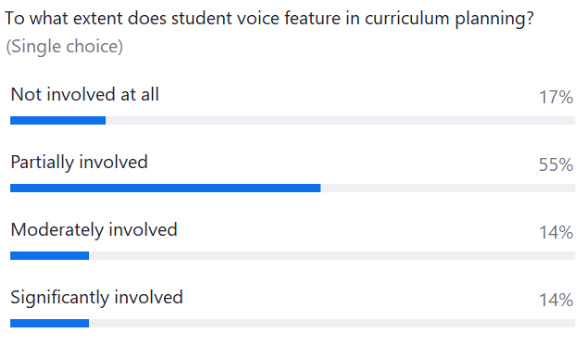Designing your curriculum around children with SEND
_1000.png)
This blog is based on Judicium’s Safeguarding ‘Sofa Session’ from the 9th of July, with our resident expert Rik Chilvers.
Introduction
We know that supporting children with SEND is not just about compliance, but about deeply embedded practice that genuinely transforms outcomes. This blog dives into how you can design your curriculum to serve all learners from the outset. We consider how to support your leaders to plan for SEND from the outset, and in doing so, build a whole-school culture that prioritises inclusion. We also cover why your curriculum is like an onion.
Poll 1

How to support your leaders in planning for SEND from the outset
When talking about designing a curriculum that is accessible to children with SEND, we must first consider leadership. Much of the advice we provide to schools when conducting SEND reviews centres around elevating decisions around SEND provision up, away from child-level decisions and into school-level leadership decisions. While decisions for individual children are impactful, changes at this level will not succeed unless they happen within a system which has considered SEND from the start. SEND considerations should be embedded into the core of your strategic planning, rather than being treated as an afterthought.
How to embed SEND priorities into wider school targets.
Schools must align their SEND priorities with their overarching School Development Plan. A SEND Action Plan (which tracks short and medium-term targets) should be closely linked with the priorities in your school’s development plan. This helps secure buy-in from other leaders, which is essential for effective SEND leadership. When SEND is viewed as integral to whole-school improvement, rather than a separate area, it becomes a shared vision and responsibility.
For example, imagine a mainstream secondary school which has identified improving children’s reading as a key priority over the next couple of years. All curriculum leaders have a related performance management target, so SLT can be confident they are factoring it into their department strategy. The SENDCO’s targets may be related to ensuring that support staff delivering reading interventions liaise with teachers, so that learning from the interventions can be reinforced in the classroom.
This all links into a broader goal: distributing the leadership of SEND. It’s easy for a SENDCO to become overwhelmed with paperwork and individual cases. While their expertise is invaluable, the strategic leadership of SEND needs to be shared across your senior leadership team, middle leaders, and, in particular, curriculum leaders. How effectively are your curriculum leads integrating SEND provision into their subject planning? Are they asking: "How will our curriculum intent be realised for all learners, including those with SEND?"
An example of what this might look like is the SENDCO organising training from the school’s Speech and Language Therapist (SaLT). Through training for curriculum leads on topics such as dual coding, tier 2 vocabulary and strategies for introducing vocabulary (such as ‘walk the word’), the SENDCO can ensure that other leaders are equipped with the skills and knowledge to embed strategies that support children with SEND into curriculum planning. This kind of approach is sometimes summed up as being ‘helpful to all pupils, harmful to none, and crucial for some’.
How effectively leaders are considering children with SEND when planning their curriculum?
As with any expectation you set in your school, it’s not enough to simply ask, “Are our curriculum leads doing X?”. Instead, you need to be asking, “How well is X working?” For the examples given above, that might mean that Heads of Department are tasked with reporting on the progress of children with SEND (collectively, or broken down into cohorts such as those with particular areas of need), and comparing this with data from before curriculum changes.
Poll 2

Building a whole-school culture that prioritises inclusion
One metric that is helpful to explore during SEND reviews is the level of involvement of children and their families in planning provision. There is significant variability in how well schools involve key stakeholders when planning the adaptations they’ll implement, including in curriculum design.
Poll 3

Co-production
Co-production with families is not just good practice; it’s a central aim of the Children and Families Act 2014. Involving learners with SEND and their parents/carers in decision-making at both individual and strategic levels is paramount. Their insights are invaluable for understanding needs and designing truly effective support. This collaborative approach strengthens provision for everyone.
Collaboration around interventions and other targeted provision comes reasonably naturally to schools, but this often doesn’t extend to curriculum design. Lots of schools are introducing booklets in KS3, particularly for humanities subjects. These can be of real benefit to children with SEND: they provide a clear map of learning points, make it very obvious when a lesson was missed and needs to be revisited, avoid the need for lots of secretarial sticking in of worksheets and writing of LOs, the list goes on. However, it's rare to see schools speaking to groups of children with SEND to find out if they’ve found the booklets helpful, or if there are tweaks to the layout of the booklets that would further improve them.
CPD
Strongly embedded whole-school inclusive practice requires investment in comprehensive staff training. It’s not enough to simply say that all teachers are teachers of SEND: we need to equip them with the knowledge and skills to make that a reality. Training from a SaLT, is one way to achieve this. Another way is to invite leaders from local alternative provisions or special schools to deliver training on how they adapt their curriculum.
Why your curriculum is like an onion
It’s helpful to use this analogy to understand the multiple layers to a well-designed curriculum and excellent teaching practice. Starting at the core of the onion, and as we move out through the layers, we’ll see how different levels of support can facilitate children accessing the curriculum.
Core
At the core of your onion are schemes of work that are designed with all learners in mind. This is your mainstream curriculum, designed to promote ambitious progress for all children and delivered by well-supported teachers. It’s the starting point for every child in your school.
This layer includes thoughtful lesson design, clear explanations, effective questioning, and opportunities for all pupils to participate and succeed. This layer should be strong enough to meet the needs of most children, including many with SEND. It’s about being "inclusive by design". We sometimes talk about differentiating within the curriculum: the idea that minor adjustments will enable children with SEND to access the curriculum at the same level as the majority of their peers. The key here is that children with SEND should access the same learning experience as their peers, wherever possible. The goal is not to give them a "different" or "more basic" curriculum, but to provide differentiated access and support within the same ambitious curriculum.
First Layer
For some children, the universal provision may not be enough, and they might need a partially differentiated curriculum. At this level, children access the same subject areas and texts as their peers, but they require significant differentiation to do so. These children may also require targeted support or interventions within the mainstream classroom or small groups. This might include specific scaffolding, adapted resources, or focused adult support, all designed to help the child access the same curriculum content as their peers. This is where careful assessment for learning is critical – identifying gaps and providing precise support.
Second Layer
A smaller number of children with more complex needs may require a fully differentiated curriculum. Just like before, these children will work on the same subject areas as their peers, but at an adjusted level that matches their needs and with additional resources. These children are likely to have an EHCP and an individual learning plan. They may require specialist equipment or input from external professionals. Even at this level, the aim remains to enable the child to engage with and progress through the broader curriculum where appropriate, adapting the model of delivery to fit the learner's needs.
Summary
The alternative to the onion, and what we want to avoid, is the "bolt-on" approach – where SEND provision is something separate, added on, or an afterthought once the main curriculum is already established. This often leads to children with SEND being given a diluted or disconnected learning experience. The onion reminds us that SEND is integral to the curriculum, not an addition.
Schools need to proactively build in layers of support, from universal high-quality teaching to highly personalised interventions, ensuring that every child can access, engage with, and thrive within your ambitious curriculum.
Key Takeaways
- Embed SEND considerations into all strategic decisions and distribute leadership for inclusion across the school.
- Foster a shared ethos of acceptance and high expectations for all, backed by consistent practices and continuous staff development.
- Design your curriculum with layers of support, starting with high-quality, universal teaching, supported by targeted and specialist provision as needed. This ensures that all pupils access the core curriculum with appropriate adaptations, rather than a separate curriculum.
How Judicium Education can help…
Judicium is committed to supporting schools in building truly inclusive environments. Our new SEND service is designed to work alongside you, providing tailored advice through on-site reviews and delivering training to your staff. If you’re curious how your school stacks up or want an external perspective, consider reaching out for a SEND Review – a fresh pair of eyes can identify strengths to build on and areas to develop when it comes to your inclusion support.
See our upcoming training sessions here.
What do Ofsted Look for when Inspecting for SEND Provision and Leadership?
If you require any SEND support in any of these steps or would like to talk to someone surrounding our SEND Support Service for your school, please do not hesitate to call us on 0345 548 7000 or email georgina.decosta@judicium.com
You can follow us on Twitter: @JudiciumSG @JudiciumEDU
If you’d like to review all of Judicium’s forthcoming sofa sessions please click here
© This content is the exclusive property of Judicium Education. The works are intended to provide an overview of the sofa session you attend and/or to be a learning aid to assist you and your school. However, any redistribution or reproduction of part or all of the contents in any form is prohibited. You may not, except with our express written permission, distribute or exploit the content. Failure to follow this guidance may result in Judicium either preventing you with access to our sessions and/or follow up content.
Related content
.png)
This blog explores how school leaders can develop SEND provision; when the right strategies are applied, leadership teams can build inclusive, confident, and impactful SEND provision that benefits every pupil.
.png)
This blog is based on Judicium’s SEND ‘Sofa Session’ from the 21st of May, with our resident expert Rik Chilvers.
.png)
This blog is based on Judicium’s SEND ‘Sofa Session’ from the 26th of March, with our resident expert Rik Chilvers.

This blog is based on Judicium’s SEND ‘Sofa Session’ from the 11th of December, with our resident expert Rik Chilvers.

As the pressure on schools increases, we need to examine the current challenges and reflect on actions that ensure every child, regardless of their strengths and needs, has access to the education they deserve. The impact this is having on the whole school community is already apparent, but how do schools and academy trusts even begin to address this?
.png)
This blog is based on Judicium’s SEND ‘Sofa Session’ from the 20th of November, with our resident expert Rik Chilvers.

SEND